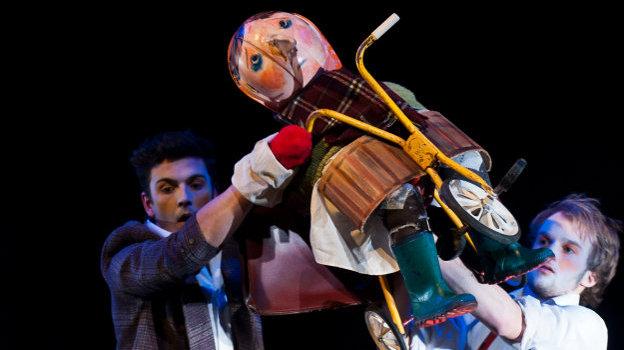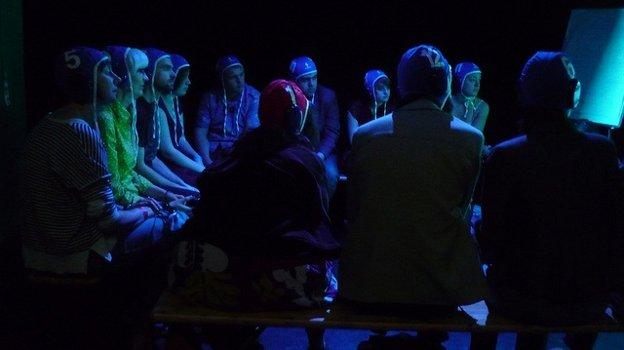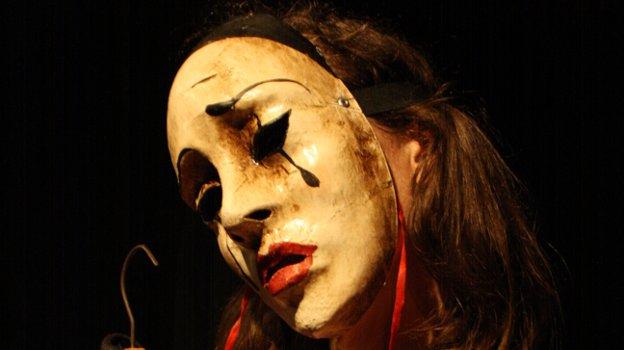In Belleville Rendez-vous, Fellswoop Theatre, recent graduates from Warwick University, bring Sylvain Chomet’s Academy Award winning animated film to the stage (with the Chomet’s own seal of approval).
The stage show starts by placing us in a cabaret watching the Les Triplettes de Belleville jazz trio (double bass, electric guitar, and accordion) – a scruffy-looking bunch of fellows, faces painted white, and dressed in pastel linen clothing – creating a deliciously dark and unmistakably French ‘film noir’ setting. You feel like you should be sitting there with a large glass of wine and a cigarette! Then, the mood changes, and brooms, bicycle wheels, cutlery, physical action and human voice are all brought into play as the story begins…
The show’s plot is essentially the same as the film’s: when the orphaned cycling fanatic Champion (who has been brought up by his grandmother) disappears during the Tour de France race, his grandmother and their overweight dog journey to Belleville to find him. Joining forces with the aforementioned ageing jazz trio, they hatch a plan to rescue Champion from the clutches of mysterious crooks who may well be members of the French Mafia… The plot thickens!
Belleville Rendez-vous is a devised piece which uses almost word-free physical performance and puppetry to extremely good effect. The staging consists of simply constructed walls creating two distinct spaces: on one side you are shown the grandmother’s house including a crackly old radio and mouldy old curtains above the sink, but then, at one point, these walls revolve to reveal the actors creating the scene behind – for example, by flapping the curtains and whistling to create an effect of wind outside.
The aesthetic of the original film is preserved in the look of the human and puppet characters (transformed effectively here from 2D to 3D) – for example, in the long noses, tiny beady eyes, and rectangular shapes of two bodyguard characters.
The puppetry is excellent. Objects from everyday life are used to create the puppets, with the head of one made from a builder’s hard hat, and the body of another a large dark brown rusty-looking suitcase. The puppeteers are always visible, and often integrated with the puppet in an effective way, as, for example, with the Dog Lady, where the puppeteer’s feet were used as the hind legs of the dog, her vocalising of the barks and grunts that emerged from the solid head of this creature adding instant comic effect throughout the show. Also very well realised were the ‘Triplets’ characters, who were dressed in long shabby fur coats with 1920s style cloche hats. They had screwed-up faces and bodies, and communicated mainly through squeals, grunts, cackles and gasps.
This was a totally engaging performance, helped by the fact that there’s little dialogue, the show relying heavily on the audience reading the visual and physical ‘text’ performed onstage – which they readily and easily did due to the brilliant characterisation, pleasing stylisation, and constant humour of the performance. As a big fan of the film I thought the translation to stage was as good as I could have hoped – a unique and imaginative production using charming vocal soundscapes, clever puppetry and witty choreography. France, with all its elegance, is brought to your lap!






